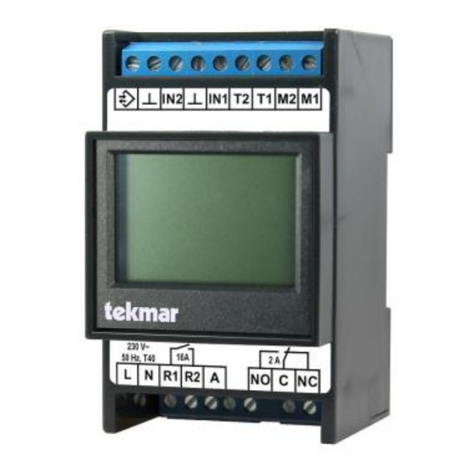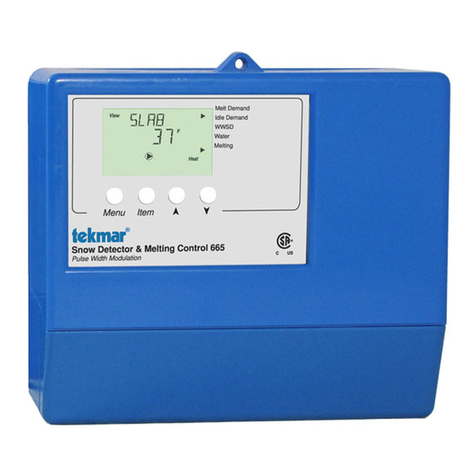
- 2 -
Connecting the sensor inputs
In order to adapt to the desired monitoring functions, you can choose to wire the inputs in three different ways:
Operation with one sensor
The Type 33.. sensor is connected to sensor input 1 for temperature and moisture monitoring.
Operation with two sensors
Two sensors can be connected to the ice and snow detector: either two combi sensors for moisture/temperature
or one combi sensor and one temperature sensor. This type of operation is recommended in case of differences
in topography or areas with pronounced differences of sun and shadow.
The measured values are collected one by one. If one of the combi sensors indicates moisture, the heating of
the open area will be activated.
The relevant measurement functions of the sensors are set in the configuration menu "Sensor".
Slab idle temperature operation
A combi sensor and a temperature sensor are connected to the ice and snow detector. A Type 33.. sensor is
connected to sensor input 1 for temperature and moisture monitoring; a type 31.. temperature sensor is
connected to sensor input 2 in order to measure the outdoor temperature (also refer to "Slab idle temperature").
Moisture measurement
If the measured temperature falls below the set "high temperature limit", the sensor heating will heat up the
sensor surface and subsquently assess if the sensor is dry or moist. If the set moisture sensitivity is exceeded,
the heating is switched on for the set minimum heating time. After the minimum heating time has passed, there
will be another moisture measurement. If the sensor is still moist, the heating will remain switched on. If the
temperature measured in the sensor reaches the set "high temperature limit" during the second or further
measurements, the switch output will be switched off prematurely.
Note: Also for sensors which are only activated for moisture monitoring, the integrated temperature sensor must
be connected and operational because the sensor temperature is required for determining moisture. Therefore
there will also be an error message for these sensors if "only" the temperature measurement is impaired.
In order to avoid incorrect measurements, the supply voltage of the ice and snow detector is monitored before
and during moisture measurement. In case the value is outside the voltage area for which correct functioning is
guaranteed, there will be an error message (refer to chapter "Error codes").
The system automatically optimizes the duration of one measurement cycle depending on the type of sensor,
the supply voltage and the sensor temperature.
Ambient temperature of moisture sensors
Depending on the type of sensor, the ambient temperature cannot be measured during the moisture
measurement and for a certain time after the measurement. This is because the temperature of the integrated
temperature sensor is influenced by the moisture measurement. During this time the system works with the last
measured ambient temperature.
Slab temperature
If two sensors are used to measure the slab temperature, the relevant slab temperature is calculated according
to the following pattern (with a hysteresis of 0,5K each) :
-Both sensors above or below the range of the high to low temperature limit: The relevant slab
temperature is the average value of both measured values.
-Both sensors within the range of the high to low temperature limit: The relevant slab temperature is the
average value of both measured values.
-One sensor outside and one sensor within the range of the high to low temperature limit: The relevant
slab temperature is the value measured within this range.
-One sensor above and one sensor below the range of the high to low temperature limit: For the relevant
slab temperature an "-!-" is displayed as an indication that there is an installation or configuration problem
(slab heating is not activated).
In this way the moisture measurement is activated at the earliest possible point in time.
Slab idle temperature mode
In the operating mode "Slab idle temperature" a temperature and moisture sensor has to be connected to
sensor input 1 and a temperature sensor (Series 31..) has to be connected to sensor input 2 (terminals 6/7) in
order to measure the outdoor temperature. The sensor types need to be defined accordingly in the configuration
menu!































